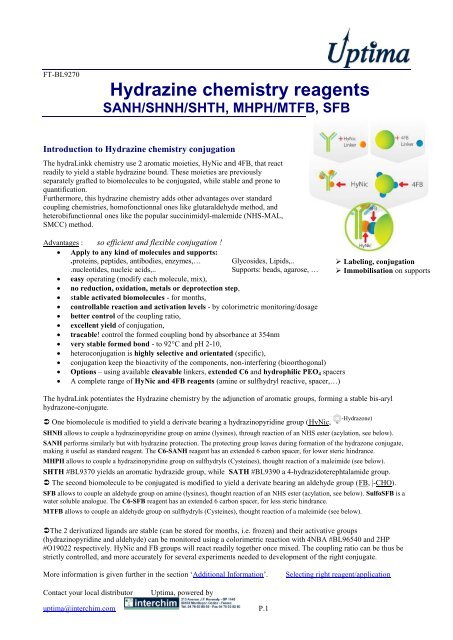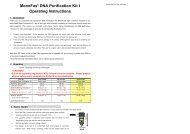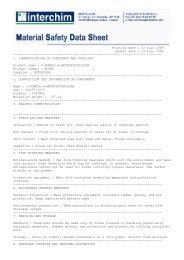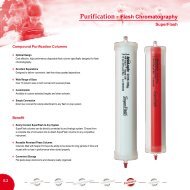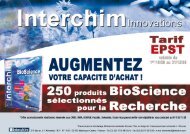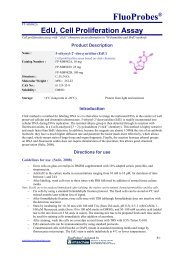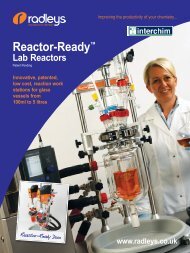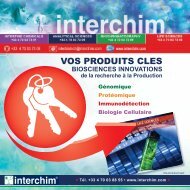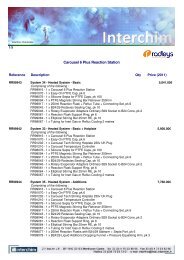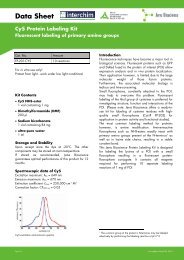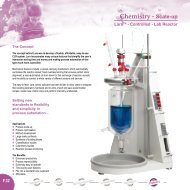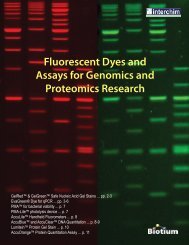Hydrazine chemistry reagents - Interchim
Hydrazine chemistry reagents - Interchim
Hydrazine chemistry reagents - Interchim
Create successful ePaper yourself
Turn your PDF publications into a flip-book with our unique Google optimized e-Paper software.
FT-BL9270<br />
<strong>Hydrazine</strong> <strong>chemistry</strong> <strong>reagents</strong><br />
SANH/SHNH/SHTH, MHPH/MTFB, SFB<br />
Introduction to <strong>Hydrazine</strong> <strong>chemistry</strong> conjugation<br />
The hydraLinkk <strong>chemistry</strong> use 2 aromatic moieties, HyNic and 4FB, that react<br />
readily to yield a stable hydrazine bound. These moieties are previously<br />
separately grafted to biomolecules to be conjugated, while stable and prone to<br />
quantification.<br />
Furthermore, this hydrazine <strong>chemistry</strong> adds other advantages over standard<br />
coupling chemistries, homofonctionnal ones like glutaraldehyde method, and<br />
heterobifunctionnal ones like the popular succinimidyl-malemide (NHS-MAL,<br />
SMCC) method.<br />
Advantages : so efficient and flexible conjugation !<br />
Apply to any kind of molecules and supports:<br />
.proteins, peptides, antibodies, enzymes,… Glycosides, Lipids,..<br />
‣ Labeling, conjugation<br />
.nucleotides, nucleic acids,..<br />
Supports: beads, agarose, … ‣ Immobilisation on supports<br />
easy operating (modify each molecule, mix),<br />
no reduction, oxidation, metals or deprotection step,<br />
stable activated biomolecules - for months,<br />
controllable reaction and activation levels - by colorimetric monitoring/dosage<br />
better control of the coupling ratio,<br />
excellent yield of conjugation,<br />
tracable! control the formed coupling bond by absorbance at 354nm<br />
very stable formed bond - to 92°C and pH 2-10,<br />
heteroconjugation is highly selective and orientated (specific),<br />
conjugation keep the bioactivity of the components, non-interfering (bioorthogonal)<br />
Options – using available cleavable linkers, extended C6 and hydrophilic PEO 4 spacers<br />
A complete range of HyNic and 4FB <strong>reagents</strong> (amine or sulfhydryl reactive, spacer,…)<br />
The hydraLink potentiates the <strong>Hydrazine</strong> <strong>chemistry</strong> by the adjunction of aromatic groups, forming a stable bis-aryl<br />
hydrazone-conjugate.<br />
One biomolecule is modified to yield a derivate bearing a hydrazinopyridine group (HyNic,<br />
-Hydrazone)<br />
SHNH allows to couple a hydrazinopyridine group on amine (lysines), through reaction of an NHS ester (acylation, see below).<br />
SANH performs similarly but with hydrazine protection. The protecting group leaves during formation of the hydrazone conjugate,<br />
making it useful as standard reagent. The C6-SANH reagent has an extended 6 carbon spacer, for lower steric hindrance.<br />
MHPH allows to couple a hydrazinopyridine group on sulfhydryls (Cysteines), thought reaction of a maleimide (see below).<br />
SHTH #BL9370 yields an aromatic hydrazide group, while SATH #BL9390 a 4-hydrazidoterephtalamide group.<br />
The second biomolecule to be conjugated is modified to yield a derivate bearing an aldehyde group (FB, |-CHO).<br />
SFB allows to couple an aldehyde group on amine (lysines), thought reaction of an NHS ester (acylation, see below). SulfoSFB is a<br />
water soluble analogue. The C6-SFB reagent has an extended 6 carbon spacer, for less steric hindrance.<br />
MTFB allows to couple an aldehyde group on sulfhydryls (Cysteines), thought reaction of a maleimide (see below).<br />
The 2 derivatized ligands are stable (can be stored for months, i.e. frozen) and their activative groups<br />
(hydrazinopyridine and aldehyde) can be monitored using a colorimetric reaction with 4NBA #BL96540 and 2HP<br />
#O19022 respectively. HyNic and FB groups will react readily together once mixed. The coupling ratio can be thus be<br />
strictly controlled, and more accurately for several experiments needed to development of the right conjugate.<br />
More information is given further in the section ‘Additional Information’.<br />
Selecting right reagent/application<br />
Contact your local distributor<br />
Uptima, powered by<br />
uptima@interchim.com P.1
FT-BL9270<br />
Select the right reagent depending on desired conjugate:<br />
Type of<br />
Conjugate molecule1 Target Reactive Group1<br />
=>use product as Linker<br />
Antibody / Ab<br />
Amino (NH2)<br />
Protein<br />
=>SANH<br />
Thiol (SH)<br />
Protein /<br />
Oligo<br />
Protein /<br />
Peptide<br />
Oligo /<br />
Peptide<br />
Protein /<br />
Supports<br />
Peptide /<br />
Supports<br />
Protein<br />
Protein<br />
Oligo<br />
=>MHPH<br />
Amino (NH2)<br />
=>SANH<br />
Thiol (SH)<br />
=>MHPH<br />
Amino (NH2)<br />
=>SANH<br />
Thiol (SH)<br />
=>MHPH<br />
3’ or 5’ Amino<br />
=>SFB, or sulfo-SFB, or<br />
SS-S-4FB (cleavable)<br />
Molecule2<br />
Protein<br />
Oligo<br />
Peptide<br />
Peptide<br />
Target Reactive Group2<br />
=>use product as Linker<br />
Amino (NH2)<br />
=>SFB<br />
Thiol (SH)<br />
=>MTFB<br />
3’ or 5’ Amino<br />
=>SFB<br />
dNTPs<br />
=>4FB-phosphoramidite<br />
N-terminus<br />
=>BOC-HyNic<br />
C-terminus<br />
=>6-FMOC-Lys-tBoc-HyNic<br />
N-terminus<br />
=>BOC-HyNic<br />
dNTPs<br />
=>4FB-phosphoramidite<br />
C-terminus<br />
=>6-FMOC-LystBoc-HyNic<br />
µsphere Beads =>4FB NanoLink Beads Ab, other protein, Amino (NH2)<br />
Agarose or 4FB-Agarose<br />
rPE, APC, perCP, =>S-HyNic<br />
Beads HRP, AlkPhos,… Thiol (SH)<br />
=>MHPH<br />
µsphere Beads =>4FB NanoLink Beads Peptide<br />
N-terminus<br />
Agarose or 4FB-Agarose<br />
=>BOC-HyNic<br />
Beads<br />
Product Information<br />
Incorporation of aromatic hydrazinopyridine and aldehyde moieties<br />
on proteins or other biomolecules<br />
Catalog #: BL9270, 10 mg BL9271, 25 mg<br />
Name: SANH (S-HyNic)<br />
Succinimidyl 6-hydrazinonicotinate acetone hydrazone<br />
MW 290.2 (M)<br />
Catalog #:<br />
Name:<br />
Catalog #:<br />
Name:<br />
Catalog #:<br />
Name:<br />
Used to convert amines to hydrazinopyridine moieties<br />
BL9330, 10 mg<br />
C6-SANH<br />
C6-Succinimidyl 6-hydrazinonicotinate acetone hydrazone<br />
MW 403.44 (K)<br />
6 carbon spacer analog of SANH<br />
BL9360, 10 mg<br />
SHNH<br />
Succinimidyl Hydraziniumnicotinate Hydrochloride<br />
MW 286.68 (M)<br />
Used to convert primary amines to hydrazinopyridine<br />
moieties. Also chelates 99mTc.<br />
BL9370, 10 mg<br />
SHTH<br />
Succinimidyl 4-Hydrazidoterephthalate.Hydrochloride<br />
MW 313.7 (M)<br />
Used to convert I amines to HyNic moieties.<br />
Contact your local distributor<br />
Uptima, powered by<br />
uptima@interchim.com P.2
FT-BL9270<br />
Catalog #: BL9390, 25 mg 6 carbon analog of SANH<br />
Name: SATH<br />
Succinimidyl 4-hydrazidoterephthate acetone hydrazone<br />
MW 317.4<br />
Used to incorporate 4-hydrazidoterephthalamide moieties on<br />
proteins or other amine containing moieties. This is a<br />
custom product ; please call for availability.<br />
Catalog #:<br />
Name:<br />
(M)<br />
Catalog #:<br />
Name:<br />
Catalog #:<br />
Name:<br />
M11771, 100 mg<br />
SFB (S-4FB)<br />
Succinimidyl-4-formylbezoate<br />
CAS: [60444-78-2]; MW 247.21 (K)<br />
Used to convert amines to benzaldehyde moieties.<br />
BL9410, 25 mg<br />
C6-SFB<br />
C6-Succinimidyl-4-formylbezoate<br />
MW 336.35 (K)<br />
Extended-spacer version of SFB<br />
Used to convert primary amines to benzaldehyde moieties<br />
CP3981, 10 mg<br />
PEO 4 -SFB (PEG 4 -SFB)<br />
.<br />
(K)<br />
Catalog #:<br />
Name:<br />
Catalog #:<br />
Name:<br />
(K)<br />
Catalog #:<br />
Name:<br />
(M)<br />
Catalog #:<br />
Name:<br />
MW 563.5 (K) desiccated<br />
PEO spacer version of SFB.<br />
The extended PEG linker enhances solubility and alleviates<br />
steric hindrance with increase in conjugate yield.<br />
BI1311, 25 mg<br />
Sulfo-SFB (sS-4FB)<br />
Sulfo-Succinimidyl-4-formylbenzoate<br />
MW 327.27 (K) desiccated<br />
Water-soluble version of SFB.<br />
Especially useful for conversion of amino surfaces such as<br />
beads and plates as this reagent is water soluble.<br />
CP3991, 10 mg<br />
SS-SFB (SS-S-FB)<br />
Succinimidyl-4-formylbezoate<br />
MW 410.5 (K) dessicated<br />
Thiol mediated cleavable version of C6-SFB. Useful for<br />
intracellular conjugate cleavage / release in cytoplasm.<br />
BL9400, 10 mg<br />
MHPH (Mal-HyNic)<br />
3-N-Maleimido-6-hydraziniumpyridine hydrochloride<br />
MW 290.2 (M)<br />
Used to convert thiols to hydrazinopyridine moieties.<br />
BZ0774, 5x1 mg<br />
MTFB (Mal-PEO 3 -HyNic)<br />
N<br />
MW 503.54 (M)<br />
O<br />
Used to convert thiol moieties to 4FB (4-formylbenzamide)<br />
moieties. Possess a PEO3 linker for increased solubility of<br />
modified biomolecule.<br />
O<br />
4FB/PEO 4-modified proteins are more water-soluble (less<br />
hydrophobic) than 4FB-modified proteins, which can eliminate<br />
precipitation issues with certain proteins.<br />
O<br />
O<br />
N<br />
H<br />
N<br />
O<br />
N<br />
O<br />
N<br />
H<br />
NH 2. HCl<br />
O<br />
O<br />
N<br />
H<br />
O<br />
H<br />
O<br />
Note:<br />
Store under inert atmosphere), dessicated, at +4°C (or frozen/long term)(K), or frozen (M)<br />
For research use only. Not for internal or external use in humans.<br />
Most products are available in 5x1mg size and bulk quantities.<br />
Contact your local distributor<br />
Uptima, powered by<br />
uptima@interchim.com P.3
FT-BL9270<br />
Directions for use<br />
The following is information and guidelines for use suit notably to<br />
conjugate proteins (or amine containing molecules such aminoallyl<br />
nucleotides, or supports). Typically, a protein 1 is activated using<br />
SANH reagent (NHS-HyNic), while the other is modified by SFB<br />
reagent (NHS-CHO).<br />
Activation levels can be controlled using a colorimetric dosage<br />
with 2HP and 4NBA <strong>reagents</strong>.<br />
Activated proteins are then simply mixed allowing conjugation.<br />
Guidelines for use – protein activation to bear<br />
HyNic, HNA or 4FB reactive groups<br />
Required <strong>reagents</strong> and equipment:<br />
Diafiltration spin columns<br />
Modification Buffer<br />
Conjugation Buffer<br />
DMF (anhydrous)<br />
2-sulfo-benzaldehyde<br />
Variable-speed bench-top microcentrifuge<br />
Spectrophotometer or Plate Reader<br />
1.5 mL microcentrifuge tubes<br />
See related products, and also additional information.<br />
Protocol for NHS derivatisation: SANH or SHNH or SFB activation step to yield a HyNic or HNA or 4FB moiety<br />
1. Preparer the protein in suitable buffer at 1-5mg/ml<br />
The protein (or amine containing molecule or support) should be in amine-free and sulfhydryl buffer at pH 7.3 to 9.<br />
Alternatively, adjust the pH, or perform buffer exchange by dialysis or desalt by another mean, to remove Tris or free<br />
aminoacids (glycine). High-level buffering capacity, i.e. 100 mM phosphate, is recommended.<br />
The concentration of the molecule to activate should be high enough to get efficient yield.<br />
Amine content can be determined by OPA colorimetric of fluorimetric dosage using OPA reagent.<br />
Protein content can be determined using BC Assay or Coo Assay (for oligonucleotides, use 260nm absorbance)<br />
Typically prepare an antibody or peptide at 2.5mg/ml concentration in PBS pH7.6 or Carbonate pH 8.3.<br />
1. Prepare a NHS modifier solution (SFB, SANH or SHTH) at 20-100mM.<br />
I.e. dissolve 2-4mg of SANH or SHNH or SFB in 100µl DMF<br />
2. Add the desired quantity of modifier solution to the protein:<br />
- Put sufficient quantity of protein to take in consideration protein loss in the desalting step..<br />
- Determine from below tables the molar ratio of NHS modifier to protein required to get desired coupled ratio.<br />
A typical condition is 10 molar equivalents of modifier for a 2mg/ml protein solution. Hence, to 2mg of antibody (1ml<br />
at 2mg/ml = 12.5µM), add 125µM of NHS modifier, that is 12.5µL of a 100mM solution of SANH (29.0mg/ml) or of<br />
SFB (24.7mg/ml).<br />
- Keep
FT-BL9270<br />
3. Incubate at room temperature for 2 hours.<br />
Shorter incubation work, but may require a quenching step to get reproducible results.<br />
Incubating at +37°C speed the reaction, but also speeds the hydrolysis of the NHS reactive group.<br />
4. Dessalt activated biomolecule using a gelfiltration column, diafiltration or dialysis.<br />
Please refer to desalting tool supplier for operating procedure.<br />
For a next conjugation, use suitable buffer: 100 mM sodium phosphate, 150 mM sodium chloride, pH 6.0.<br />
The 4FB linker molecules incorporated on biomolecules are stable at 4°C for >30 days.<br />
5. Determine the protein concentration using a colorimetric method<br />
such as BC Assay (UP40840) or Bradford Assay (UPF4600) or any other suitable assay.<br />
Determine the HyNic (or 4FB) content by colorimetric dosage using 4NBA (or 2HP) – see below.<br />
Troubleshooting for protein activation by NHS modifiers<br />
Problem Possible Cause Solution<br />
Protein was not modified or poorly<br />
modified.<br />
Protein has been contaminated with<br />
amine containing compounds<br />
Desalt the protein more thoroughly with a<br />
new desalting column<br />
The added quantity of modifier was Check for calculations.<br />
too low<br />
The concentration of the protein was<br />
too low<br />
Increase the concentration of the protein to<br />
>2.0 mg/mL<br />
NHS was hydrolyzed in the<br />
modifier (SANH, SHTH; SFB)<br />
Wet or poor quality DMF/DMSO<br />
hydrolyzed the NHS ester<br />
Use a good quality anhydrous<br />
DMF/DMSO to solubilize the modifier<br />
Too high modification level<br />
The added quantity of modifier was<br />
too high and made modified protein<br />
unstable.<br />
(SANH, SFB, SHTH).<br />
Check for calculations.<br />
Check for presence of aggregates, protein<br />
loss (assay before/after each step).<br />
Protocol for MAL derivatisation: MHPH or MTFB activation step to yield a HyNic or 4FB moiety<br />
The molecule to be derivatized to yield a HyNic or 4FB moiety should be in a sulfhydryl-free buffer at pH 7.3 to 9.<br />
Perform buffer exchange by dialysis or desalt by another mean in case DTT or other reducers are present. Buffers<br />
containing Tris or Glycine are also not recommended.<br />
Typically prepare an SH-containing antibody or peptide at 1-5mg/ml concentration in Conjugation Buffer (0.1M<br />
sodium phosphate, 0.15M sodium chloride, pH 6.0)<br />
1. Prepare a MAL modifier solution (MHTH or MFTB)<br />
Dissolve 2-4mg of MHPH in 100µl of anhydrous DMF.<br />
The MHPH/DMF stock solution is stable for 2 weeks if prepared with anhydrous DMF and stored desiccated.<br />
2. Mix protein solution and MHPH or MTFB<br />
solution in desired molar ratio,<br />
and incubate for 2hours.<br />
IgG concentration<br />
MHPH molar<br />
equivalents added<br />
Suitable ratio of MHPH for antibody activation: 1.0 mg/ml 20<br />
30<br />
4.0 mg/ml 15<br />
20<br />
25<br />
5. Determine the protein concentration using a colorimetric method<br />
such as BC Assay (UP40840) or Bradford Assay (UPF4600) or any other suitable assay.<br />
Determine the HyNic (or 4FB) content by colorimetric dosage using 4NBA (or 2HP) – see below.<br />
Determined ratio<br />
of HyNic/protein<br />
(pH 7.4)<br />
5.3<br />
7.8<br />
4.6<br />
6.1<br />
7.8<br />
Contact your local distributor<br />
Uptima, powered by<br />
uptima@interchim.com P.5
FT-BL9270<br />
Troubleshooting – for protein activation by maleimide modifiers<br />
Problem Possible Cause Solution<br />
Protein was not modified Protein has been contaminated with Desalt the protein more thoroughly with a new<br />
or poorly modified. sulfhydryls (or amines) containing gelfiltration column or VivaSpin diafiltration<br />
compounds<br />
device<br />
The concentration of the protein was Increase the concentration of the protein to >2.0<br />
MHPH was hydrolyzed<br />
too low<br />
Wet or poor quality DMF/DMSO<br />
hydrolyzed the Maleimide groups<br />
mg/mL<br />
Use a good quality anhydrous DMF/DMSO to<br />
solubilize the MHPH molecule.<br />
Protocols for monitoring HyNic or 4FB moieties<br />
Protocol to quantitate hydrazinopyridine incorporation by 4-NBA #BL9650:<br />
4-NBA (p-NBA) reagent must be protected from light.<br />
1. Prepare a 0.5M 4NBA solution: Dissolve 4NBA in DMF, and add the required volume to Conjugation Buffer.<br />
The solution is stable for 1 month at+4°C when protected from light.<br />
2. Add an aliquot of the <strong>Hydrazine</strong>-modified protein solution to the pNBA solution and incubate at +37°C for 1<br />
hour, or at room temperature for 1 hours. Determine the absorbance at 390nm against a blank (equal aliquot of buffer +<br />
pNBA solution).<br />
3. The hydrazine/protein MSR = Abs 380nm / 20 000 / [protein concentration in mol/L]<br />
where A380nm: absorbance at 380nm (1cm path), to estimate hydrazine concentration (EC:20 000)<br />
[Protein M]: protein concentration in assay sample in M, as dosed in step 5.,<br />
or calculate as = [protein concentration in mM] x (used volume in ml) / (total assay volume in ml)<br />
Protocol to quantitate 4FB aldehyde reactive groups incorporation by #O19022 :<br />
2HP reagent must be protected from light.<br />
1. Prepare a 0.5mM 2HP solution in 100mM MES pH4.7 buffer<br />
Dissolve 2HP in DMF, and add the required volume to Conjugation Buffer. The solution is stable for at least 1 month at<br />
+4°C when protected from light.<br />
Other buffers may need to be used if protein precipitation occurs due to the pI of the protein. For example, Citrate buffer (pH 5-6) can be used<br />
in place of MES (4.7).<br />
2. Add an aliquot (10µl) of the benzaldehyde-modified protein sample (1-5mg/ml) to the 2HP solution (490µl<br />
0.5mM) and incubate at +37°C for 1 hour, or at room temperature for 2 hours. Determine the absorbance at 390nm<br />
against a blank (equal aliquot of buffer + 2HP solution).<br />
3. Calculate the number of aldehyde moieties/protein (MSR: Molar Substitution Ratio [protein]/[Hydrazone]):<br />
The aldehyde/protein MSR = Abs 350nm / 18 000 / [protein concentration in mol/L]<br />
where A350nm: absorbance at 350nm (1cm path), to estimate hydrazone concentration (EC:18 000)<br />
[Protein M]: protein concentration in assay sample in M, as dosed in step 5.,<br />
or calculate as = [protein concentration in mM] x (used volume in ml) / (total assay volume in ml)<br />
Note: if the number of reactive 2-hydrazinopyridine moieties on the biomolecule is a problem for quantitation, because of biomolecule<br />
precipitation for instance, uses a solution of SBF 0.5mM in Conjugation buffer instead of pNBA (follow the same protocol).<br />
Contact your local distributor<br />
Uptima, powered by<br />
uptima@interchim.com P.6
FT-BL9270<br />
Guidelines for use – protein conjugation<br />
Bring the concentration of activated proteins to 1‐5 mg/mL in buffer pH 6.0 for the conjugation step.<br />
1. Mix the activated the hydrazine-protein1 (SANH-, SHTH-, or MHPH-activated) and benzaldehydeprotein2<br />
(SFB- or MTFB-activated).<br />
-for proteins: at a 1:1 to 1:3 molar ratio –eventually higher (1:10) -depends on protein size and desired features-,<br />
-for oligonucleotides: at a 1:1.5 molar ratio<br />
Note: please refer to section 'Technical and Scientific Information' of kit #BL150 for specific applications (high MW conjugate preparation)<br />
2. Incubate for 2-16 hours at room temperature in Conjugation buffer.<br />
.Note: The reaction can be speeded using 1-10mM TurboCatalys reagent (see additional info). This is especially useful for large proteins.<br />
.Note: The extent of conjugation can be monitored according step 4. Alternatively, determine it on an aliquot of the reaction mixture by<br />
SDS-PAGE analysis of a protein-protein conjugate, or by PAGE analysis for protein-oligonucleotide conjugate.<br />
.Note: In case excess of hydrazinopyridine moieties remain unreacted on the biomolecule, and not desired, they can be quenched by using a<br />
solution of 2-SBA (#A42050) at 0.5mM in Conjugation Buffer for 2 hours.<br />
An alternative method is desalting by suitable mean.<br />
3. Desalt the conjugate. The conjugate can be isolated by standard size exclusion chromatography (gelfiltration<br />
columns UP84874), diafiltration (UptiSpin), or dialysis (CelluSep). For purer conjugates, we recommend FPLC to<br />
isolate protein-protein, and size exclusion for protein-oligonucleotide conjugates.<br />
4. Controlling the conjugation level:<br />
The HyNic‐4FB conjugation bond is chromophoric: the conjugate bond absorbs at 354 nm and has a molar extinction<br />
coefficient of 29 000. This allows :<br />
(1) real time spectrophotometric monitoring of a conjugate reaction,<br />
(2) ability to ‘visualize’ the conjugate during chromatographic purification using a UV or photodiode array detector,<br />
(3) quantification of conjugation.<br />
.Note: the absorbance measurement may be ruined in case the biomolecules or the used buffer absorb at 354nm.<br />
Additional information<br />
●NHS & Maleimide reactions steps – for protein "activation"<br />
NHS-ester derivatives (SANH, SHTH, SFB) are suited for direct labeling of amino groups in proteins (typically<br />
Lysine residues) and aminated DNA/RNA (i.e aminoallyl nucleotides labeled materials).<br />
The chemical group N-hydroxysuccinimidyl (NHS) reacts optimally at neutral pH or higher in aqueous phase on<br />
primary (–NH2) and secondary amines (-NH-) (in fact on its deprotonated form): i.e. amines present in proteins (Lys<br />
amino-acid) and in a lower proportion on NH2 located in terminal peptidic chains. The reaction competes with<br />
hydrolysis that increases with pH, and with the high dilutions of the molecule that should be labeled. Please refer to the<br />
literature, or the technical sheet FT-BA6800 (NHS-FluoProbes labels) for a standard protein coupling protocol.<br />
Maleimide derivatives (MHPH, MTFB) are suited for labeling of thiol groups of proteins or other molecules, e.g.<br />
specific labeling of cysteine. Please refer to the literature, or the technical sheet FT-BA6810 (Maleimide-FluoProbes<br />
labels) for a standard protein coupling protocol.<br />
The proteins to be conjugated should be prepared in suitable buffer (devoid of amine or sulfhydryls).<br />
A quenching step to neutralize un-reacted NHS (i.e. by lysine) or Maleimide agents (i.e.by cysteine), or a desalting step<br />
to remove them, may be required if one of the activated molecule may be modified by the excess reagent of the other<br />
activation step. It is also needed when checking for the activation level (HyNic, or 4FB quantitation)<br />
Determine the concentration of the protein to be modified using the BCA assay (UP40840A) or spectrophotometrically<br />
if the extinction coefficient of the protein is known. The extinction coefficient for antibodies is ~1.4-1.6 for a 1 mg/mL<br />
solution.<br />
Contact your local distributor<br />
Uptima, powered by<br />
uptima@interchim.com P.7
FT-BL9270<br />
●HyNic/4FB conjugation<br />
The recommended pH for antibody conjugation is 6.0. The conjugate bond is stable to 92°C and pH 2.0-10.0.<br />
Unlike thiol-based conjugation protocols where reducing <strong>reagents</strong> are required that that can compromise the activity of<br />
proteins by cleaving disulfide bonds, the HyNic-4FB conjugation couple leaves disulfide bonds intact. No oxidants,<br />
reductants or metals are required in the preparation of conjugate.<br />
The HyNic/4FB reaction can be catalyzed but the TurboLink Catalyst (1). This is especially effective for large<br />
biomolecule conjugations. In the case of antibody-protein conjugations the addition of 10 mM TurboLink Catalyst<br />
Buffer to the reaction mixture converts >95% of the antibody to conjugate in ~2 hours using 1-2 mole equivalents of<br />
second protein.<br />
The HyNic-4FB conjugation couple is chromophoric- the conjugate bond absorbs at 354 nm and has a molar extinction<br />
coefficient of 29000. This allows (1) real time spectrophotometric monitoring of a conjugate reaction, (2) ability to<br />
‘visualize’ the conjugate during chromatographic purification using a UV or photodiode array detector and (3)<br />
quantification of conjugation.<br />
Furthermore, the level of incorporation of HyNic groups can be quantified colorimetrically as reaction with 2-<br />
sulfobenzaldehyde (2NPA) yields a chromophoric product that absorbs at A350 with a molar extinction coefficient of<br />
20000. See the above procedures to guide user.<br />
SANH (S-HyNic)<br />
SANH reagent (S-HyNic, NHS-HyNic) is a Succinimidyl (NHS) ester that converts amines on biomolecules and<br />
surfaces to HyNic linkers for conjugation to 4FB-modified biomolecules, in a single step. Beside this modifier function,<br />
the introduced HyNic moiety (6-hydrazinonicotinamide) acts as a linker that forms stable covalent conjugates with<br />
biomolecules possessing 4FB (4-formylbenzamide) incorporated linkers. SANH is thus a heterobifunctionnal<br />
crosslinker for SH-containing molecules and 4FB-modified molecules.<br />
SANH is most widely used to produce a variety of antibody-related conjugates such as IgG-HRP, IgG-AP and IgGoligos.<br />
Conjugates of other antibody fragments have also been made (scFv, Fab, and F(ab)’). SANH is also used for the<br />
synthesis of numerous other conjugates including: general protein-protein, protein-peptide, peptide-oligonucleotide,<br />
enzyme-oligonucleotide, and DNA or RNA-protein conjugates. Bioconjugates made using SANH can be used in<br />
ELISA assays, Immuno-PCR, in situ detection (FISH), Westerns, Southerns, and in many other biological applications.<br />
The advantages of the SANH-4FB linker system include a unique control to the entire conjugation process, thanks to:<br />
●reaction specificity for the activation step: SANH readily reacts with primary amines on a protein (ε-amino group of<br />
lysine) via an NHS-ester, yielding a HyNic-activated molecule.<br />
●traceability: SANH introduces UV-traceable HyNic groups (hydrazinonicotinate) into proteins or other biomolecules,<br />
bringing unique control to the entire conjugation process. Furthermore, it can be quantitate using 4NBA.<br />
●reaction specificity for the conjugation step: the introduced HyNic group reacts only with aromatic aldehydes, even<br />
in the presence of -NH2, -SH, -COOH and other protein functionalities). Hence aminated molecule1 modified by<br />
SANH –i.e. a HyNic-modified peptide, antibody or oligos) reacts to form stable conjugates in the presence of aminated<br />
molecules2 modified by SFB (i.e.aromatic aldehyde-modified proteins or nucleic aminollyl acids).<br />
Solubility: >50mg/mL in DMF.<br />
See<br />
HyNic/4FB conjugation additional information.<br />
protocols: protein activation and protein conjugation.<br />
References - SANH<br />
1.Dirksen, A., et al., Nucleophilic catalysis of hydrazone formation and transimination: implications for dynamic covalent <strong>chemistry</strong>.<br />
J Am Chem Soc, 2006. 128(49): p. 15602•]3.<br />
2.Igor A. Kozlov, Peter C. Melnyk, Katie E. Stromsborg, Mark S. Chee, David L. Barker, Chanfeng Zhao, Efficient strategies for the<br />
conjugation of oligonucleotides to antibodies enabling highly sensitive protein detection, Biopolymers 2004, 73, 621.<br />
3.Ryan C. Bailey, Gabriel A. Kwong, Caius G. Radu, Owen N. Witte, and James R. Heath, DNA•]Encoded Antibody Libraries: A<br />
Unified Platform for Multiplexed Cell Sorting and Detection of Genes and Proteins, J. Amer. Chem. Soc. 2007, 129, 1959•]1967.<br />
Contact your local distributor<br />
Uptima, powered by<br />
uptima@interchim.com P.8
FT-BL9270<br />
SHTH<br />
SHTH (BL9370) is homologous to SANH reagent. It is an aromatic hydrazide linker used to incorporate HTA (4-<br />
hydrazido-terephalamide) linkers onto biomolecules through their amino group via an activated ester (i.e. NHS). HTA<br />
linkers form heat labile hydrazide-based hydrazones with aromatic aldehydes such as 4FB (4-formylbenzamide).<br />
Solubility: >50mg/mL in DMF.<br />
See<br />
HNA/4FB conjugation additional information.<br />
protocols: protein activation and protein conjugation.<br />
References - SHTH<br />
1. Dirksen, A., et al., Nucleophilic catalysis of hydrazone formation and transimination: implications for dynamic covalent<br />
<strong>chemistry</strong>. J Am Chem Soc, 2006. 128, 15602-3.<br />
SFB (S-4FB)<br />
SFB (succinimidyl-4-formylbenzoate, S-4FB 2) is used to convert amino groups to aromatic aldehydes 4FB (4-<br />
formylbenzamide groups). Addition of a HyNic-modified biomolecule to a 4FB-modified biomolecule or surface<br />
directly leads to the formation of the conjugate.<br />
For amino-modified surfaces it is recommended to use sulfo-S-4FB.<br />
SFB is thus a heterobifunctionnal crosslinker for NH2-containing molecules and 4FB-modified molecules.<br />
The advantages of the SFB-HyNic linker system include reaction specificity, UV-traceability, and the unique control it<br />
brings to the entire conjugation process.<br />
Solubility: >50mg/mL in DMF.<br />
References - SFB<br />
1. Dirksen, A., et al., Nucleophilic catalysis of hydrazone formation and transimination: implications for dynamic covalent <strong>chemistry</strong>.<br />
J Am Chem Soc, 2006. 128(49): p. 15602-3.<br />
2. Igor A. Kozlov, Peter C. Melnyk, Katie E. Stromsborg, Mark S. Chee, David L. Barker, Chanfeng Zhao, Efficient strategies for the<br />
conjugation of oligonucleotides to antibodies enabling highly sensitive protein detection, Biopolymers 2004, 73, 621.<br />
3. Ryan C. Bailey, Gabriel A. Kwong, Caius G. Radu, Owen N. Witte, and James R. Heath, DNA-Encoded Antibody Libraries: A<br />
Unified Platform for Multiplexed Cell Sorting and Detection of Genes and Proteins, J. Amer. Chem. Soc. 2007, 129, 1959-1967.<br />
MHPH (Maleimide-HyNic)<br />
MHPH (Maleimide HyNic) is a modifier that converts thiols on biomolecules (i.e. Cysteins) and surfaces to HyNic<br />
linker molecules, in a single step. The introduced HyNic moiety (6-hydrazinonicotinamide) acts as a linker that forms<br />
stable covalent conjugates with biomolecules possessing 4FB (4-formylbenzamide) incorporated linkers. MHPH is thus<br />
also a heterobifunctionnal crosslinker for SH-containing molecules and 4FB-modified molecules.<br />
The advantages of the MHPH-4FB linker system include reaction specificity, UV-traceability, and the unique control it<br />
brings to the entire conjugation process.<br />
Hydrazone <strong>chemistry</strong> catalyser<br />
TurboLink Catalyst Buffer #HT1820<br />
TurboLink Catalyst is used to catalyze the Hydralink bond formation reaction between 4FB modified biomolecules and<br />
HyNic modified biomolecules. It is added at 100-300 fold dilution, and the conjugation reaction is complete in 1-2<br />
hours . This reagent is particularly useful for conjugations of large biomolecules; antibodies, proteins, enzymes, and<br />
surfaces.<br />
Contact your local distributor<br />
Uptima, powered by<br />
uptima@interchim.com P.9
FT-BL9270<br />
Hydrazone <strong>chemistry</strong> colorimetric <strong>reagents</strong><br />
4NBA (or p-NBA) #BL9650 (used to quantitate the level of hydrazide and hydrazine modification)<br />
2HP #O19022 (used to quantitate the level of aldehyde modification)<br />
2SBA #A42050 (used to cap hydrazinopyridine)<br />
See protocols above.<br />
Hydrazone <strong>chemistry</strong> <strong>reagents</strong> for organic synthesis<br />
6-FMOC-HNA BL9740, 100mg BL9741, 500mg<br />
6-FMOC-hydrazinonicotinic acid; MW: 375.2<br />
Used to incorporate hydrazine moieties during solid or solution phase peptide synthesis.<br />
6-FMOC-HNA-Osu BL9760, 100mg BL9761, 500mg<br />
Succinimidyl 6-FMOC-hydrazinonicotinate; MW: 472.2<br />
Used to incorporate hydrazine moieties during solid or solution phase peptide synthesis.<br />
6-BOC-HNA (BOC-HyNic) BL9750, 100mg BL9751, 500mg<br />
6-BOC-hydrazinonicotinic acid; MW: 253.1<br />
Used to incorporate hydrazine moieties during solid or solution phase peptide synthesis.<br />
6-BOC-HNA-OSu BL9770, 100mg BL9771, 500mg<br />
Succinimidyl 6-BOC-hydrazinonicotinate; MW: = 350.3<br />
Used to incorporate hydrazine moieties during solid or solution phase peptide synthesis.<br />
C6-HNAA BL9780, 100mg BL9781, 500mg<br />
6-hydrazinonicotinic acid acetone hydrazone; MW: 306.4<br />
Used to incorporate protected hydrazine moieties with extended six carbon linker during peptide synthesis<br />
HNA<br />
6-Hydrazinonicotinic Acid; MW: 153.1<br />
Precursor molecule.<br />
BL9790, 100mg<br />
BOC-HNA BL9810, 100mg BL9811, 500mg<br />
(4-BOC-hydrazido) terephthalic acid; MW: 280.3<br />
Precursor molecule.<br />
BOC-HTA-OSu BL9820, 100mg BL9821, 500mg<br />
Succinimidyl 4-BOC-hydrazido) terephthalate; MW: 377.4<br />
Precursor molecule.<br />
FMOC Lysine-ε-(6-Boc-HyNic)OH (FMOC-Lysine-t-Boc-HNA) JV3390, 100mg<br />
JV3391, 500mg<br />
MW: 603.68<br />
used to incorporate HyNic (6-hydrazinonicotinamide) moieties onto the C-terminus or internal positions of peptides during solid or solution phase synthesis or<br />
onto a small molecule, surface, or polymer with base-labile protection<br />
Ideal for linking peptides to any biomolecule or surface to improve purification, detection, delivery, or targeting.<br />
FEATURES LINKERS:<br />
6-Boc-HNA<br />
6 BOC HNA (6-BOC-hydrazinonicotinic acid)<br />
allows for peptide activation for linking peptides to<br />
any biomolecule or surface to improve purification,<br />
detection, delivery, or targeting.<br />
6-BOC-HNA is used to<br />
incorporate BOC-protected HyNic<br />
(6-hydrazinonicotinamide)<br />
moieties onto peptides during<br />
solid or solution phase synthesis<br />
. .<br />
or onto a small molecule, surface, or polymer where acid-labile protection is required. It can be coupled to the N-<br />
Contact your local distributor<br />
Uptima, powered by<br />
uptima@interchim.com P.10
FT-BL9270<br />
terminal amino group as the last step in the synthesis, prior to cleavage, or coupled to the side-chain of a Lys residue<br />
which was introduced using an appropriately orthogonally protected derivative such as Lys(ivDde) or Lys(Mtt). The<br />
linker requires activation for incorporation during peptide synthesis. HyNic-modified peptides are readily conjugated to<br />
4FB-modified biomolecules. Ask for paper: “A New Generation of Peptide Conjugation Products”<br />
6-Fmoc-Lysine-t-Boc-HNA<br />
. .<br />
Related / associated products<br />
<br />
<br />
ControlledAmine Conjugation Kits: inquire<br />
Desalting devices:<br />
Dialysis devices (FAL, GebaFlex) UltraFiltration spinners (VivaSpin PH) Gelfiltration columns<br />
See Products Highlights, BioSciences Innovations catalogue and e-search tool.<br />
Ordering information<br />
Catalog size quantities and prices may be found at http://www.interchim.com<br />
Please inquire for higher quantities (availability, shipment conditions).<br />
For any information, please ask : Uptima / <strong>Interchim</strong>; Hotline : +33(0)4 70 03 73 06<br />
Disclaimer : Materials from Uptima are sold for research R&D use only, and are not intended for food, drug, household, or cosmetic use.<br />
Uptima is not liable for any damage resulting from handling or contact with this product.<br />
Products are protected by US Patents 5,206,370, 5,420,285, 5,753,520, and 5,769,778, and EU Patent 0.384,769.<br />
Rev.M03E-K10E-H0131E<br />
Contact your local distributor<br />
Uptima, powered by<br />
uptima@interchim.com P.11


